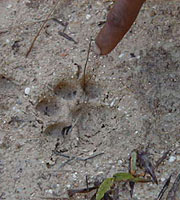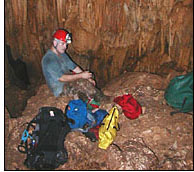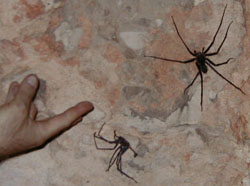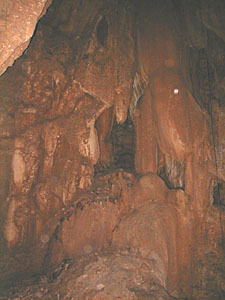|
An End Well-Worth the Wait
Our plan for eighth and final day of the project was to check out point X6. If it didn't turn out to be a sinkhole, we would visit a few large sinkholes (~100m wide entrances) we already knew about. We headed to the jungle for the last time with our spirits high from the success of the previous day.
The day started out with an ominous sign. At the head of the trail into the jungle, William spotted the paw print of a puma. Large cats such as the puma and the jaguar are often spotted in the region. Noting the shape of the print, we decided to be on the lookout for more as we headed further into the jungle.

After hiking for about 3 kilometers, we began seeing signs of the ancient Maya everywhere. We had been climbing the gradual slope of a valley modified with agricultural terraces. At the top of the climb, where the land began to flatten out, we noticed moss-covered rocks of a large platform wall, barely visible under dense jungle foliage. We searched the area and discovered that there were three small pyramid structures further back on the long platform. We noted the location on our maps so we could report the find to the Belize Department of Archaeology.
After we had hiked approximately 1.5 more kilometers, the GPS countdown began. When we drew within 100 meters of point X6, the GPS unit lost contact with the satellites. However, we had the point marked on the map, so we continued in its general direction. Bruce headed down the slope of the mountain and disappeared behind some large limestone boulders. At this point, the GPS signal kicked back in.
Bruce called out, "I've got one...how far away is the point?"
"25 meters!" Cameron shouted.
Bruce's head popped up from behind a boulder. "That's how far away I am from you, and you are going to love this!"
Bruce had dropped down right on the area of point X6, which marked a semicircular depression about 5 meters deep. The difference between this and points 12, 13, 4, 5, 1, 2, 3 and X3, X4, and X5 is that there was a small cave entrance leading into the mountainside at the base of the depression. The entrance was not a vertical drop but rather a steep slope. There was evidence that the Maya walled the cave entrance with large stones, which were later pushed aside and knocked into the entrance by looters.
We donned our helmets, grabbed our packs, and headed into the cave. To our surprise, we entered a chamber approximately 100 meters long and 75 meters wide. There was evidence of the ancient Maya everywhere--architecture, pottery, modified speleothems, carbon, and lithic material. It seems that the Maya had built small platforms upon which they conducted underworld rituals. The majority of these platforms contained broken pottery fragments and evidence of burning.
We explored the massive chamber for about an hour and encountered a number of underworld denizens such as spiders and centipedes.
During our exploration we discovered a small passage leading out of the main chamber that had been blocked by the Maya. We squeezed through the small opening in the wall that the looters had cleared away and entered a large chamber with beautiful flowstone drapery and a large chasm. We found a small passage underneath a large cave formation that led to a small natural platform overlooking the drop. We geared up again for rappelling and descended 20 meters into the abyss.
 |
| We followed a small passage (above) leading out of the main chamber. Bruce gets ready to put on his climbing gear (right). The small hole in the formations behind him leads to the 20-meter vertical drop within the cave. |
|
 |
When we reached the bottom, we were faced with yet another vertical drop of approximately 15 meters. The floor was littered with pottery fragments, and the flowstone formations in the area were burned and modified. It appears that the Maya either lit fires or burned torches in the center of a large columnar formation, which would have glowed brilliantly and cast shadows throughout the chamber.
Unfortunately, the long hike and the time spent exploring the main chamber had conspired against us. As it was now quite late in the day, we realized that it would be close to dark by the time we ascended to the main level and hiked back to the truck. We decided not to rig up our ropes for the second drop, to leave us something to look forward to on our next journey. As tempting as it was to explore further, we rigged up our ropewalkers instead and made the climb back of the abyss, leaving the second drop as a mystery to be explored in the future.

| Getting out is always harder than getting in! |
Exhausted, we began the long hike home. We were wary of the pumas roaming the jungle around us, but our good fortune only brought us beautiful butterflies on the trek home. We reached the vehicle in record time--with the sun still in the sky--and drove back to our base camp. Our project's final day was rewarding and exciting, leaving us with the promise of more discoveries in our future expeditions!
| 







